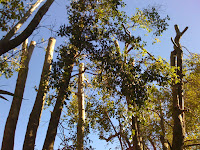
Just up the street from me lives the global headquarters of a little Internet startup named
Facebook. The company moved into the former Hewlett-Packard digs at
1601 California last year, making some interesting architectural updates but not really touching the landscape. One of the defining features of the 8.5-acre site was a large Valley Oak (
Quercus lobata), which unfortunately was surrounded by lawn for decades. It may look nice and clean, but
oaks — even the riparian Valley Oak — and lawns simply aren't compatible. The lawn requires far too much water for the oak's liking, and all that shallow irrigation encourages fungus that stresses, weakens and eventually kills the oak.

Well, Sunday a gust of wind brought the inevitable, and around 10:00 a.m. the tree blew over.
 |
| Rotten to the core. |
The
arborists were still hard at work removing the body some six hours later, and I came by just in time to get a good look at the trunk. I was struck by the amount of rot in the heartwood.
 |
| That grayish block just right of center? Concrete. |
I haven't counted the rings yet, but the arborists and I guessed the tree was at least 80 years old. It's an ignominious end for such a stately specimen; but are we really surprised? Urban trees are subject to all sorts of ecological insults, from incompatible irrigation to soil compaction, pollution, and sheer human ignorance — the arborist pointed out where concrete had been used to fill a void in the trunk, probably 30 years ago (by the way, please never do this).
There were no outward signs of trouble, and I'm really glad that the huge tree came down on a Sunday morning when the site was largely empty of people. But it is a cautionary tale: if you have a special tree on your property,
care for it. Also, cherish it. I don't know how much the Facebook folks appreciated this tree, but it would have been the perfect social hub if the social network had simply pulled out that lawn, put in a more
compatible landscape, and added a few benches and tables.
And finally, if you've got a specimen like this in your neighborhood, document it: I was surprised by how few photos I could find of this tree. (The first one above is from Google's "street view.") It's a reminder that nothing lasts forever, and some day we'll want to remember the tree that was.























